This article was co-authored by Catherine Cheung, DPM. Dr. Catherine Cheung is a board certified Podiatrist based in San Francisco, California. Dr. Cheung specializes in all aspects of foot and ankle care, including complex reconstruction. Dr. Cheung is affiliated with the Brown & Toland Physicians and the Sutter Medical Network. She earned a DPM from the California College of Podiatric Medicine, completed her residency at the Encino Tarzana Medical Center, and completed a fellowship at the Kaiser Permanente San Francisco Medical Center. She is board certified by the American Board of Podiatric Surgery.
There are 12 references cited in this article, which can be found at the bottom of the page.
This article has been viewed 198,424 times.
Itchy feet may be caused by dry skin, eczema, an infection, or – less commonly – an underlying medical condition. Itchy skin can be uncomfortable, and scratching it can cause bleeding and infection. Fortunately, the most common causes of itchy feet can be treated at home. Treat your itchy feet by identifying the cause of the itchiness and using appropriate natural remedies or medications.[1]
Steps
Managing Itchy Feet at Home
-
1Moisturize dry skin. Dry skin can be very itchy, especially for older adults whose skin may be thinner. If your itchy feet have dry, flaky skin, use a daily moisturizing cream, lotion, or ointment on your feet every day. Rub it into your heel, sole, sides and tops of your feet, and between your toes. Look for a product with a petrolatum base, which can soften and moisturize even dry, cracked skin.[2]
-
2Use cool water. Soak your feet in cool water, or place a cool wet cloth against the itchy areas of your feet. Cool water can be soothing to irritated, itchy skin.You can do this daily, or even several times daily - but if soaking often, be sure to moisturize your skin afterwards.[3]
- If you’re using a cloth for your feet, reserve it just for that purpose in case you’re dealing with a fungus.
Advertisement -
3Try an oatmeal soak. Oatmeal baths have traditionally been used to soothe itchy skin. Add two cups of ground oatmeal and one cup of baking soda to your bath, and soak your feet for a natural itch remedy. This safe and gentle remedy can be used daily.
-
4Experiment with a saltwater soak. Soak your feet in salt water to relieve aching and potentially help with itching and irritation. Dissolve 2 teaspoons of salt for each pint of warm water you use. Use a shallow pan or a few inches of water in the bathtub - enough to cover the tops of your feet. Soak for 5-10 minutes.[4]
- See how salt water works for you. It may help, but the salt could also worsen any itching by drying out the skin even more.
- You can do this hourly until your itching improves. Salt can dry out your skin, so rinse your feet in cool water and moisturize your feet after your salt soak.
-
5Identify and avoid irritants. Itchiness can be caused by even a mild allergic reaction to something you’re wearing or a product you’re using.
- OTC antihistamines may relieve itching that’s caused by allergic reactions.[5]
Treating Athlete’s Foot
-
1Recognize athlete’s foot. One of the most common causes of itchy feet, athlete’s foot usually causes a red, scaly rash on and in between your toes. Your feet may be itchiest right after removing your socks and shoes. You might get athlete’s foot on just one foot or on both.[6]
- Athlete’s foot is caused by moisture, often from exercise or heat. Be sure to remove your shoes and change into dry socks so that your feet can also dry.
- You might also get blisters on your feet, or ulcers – areas where your skin rubs off.
- One type of athlete’s foot starts on the sole of your foot and causes dryness and scaling that travels over the side of your foot.
-
2Get an over-the-counter (OTC) antifungal medication. Mild athlete’s foot can often be treated with OTC powders, sprays, or ointments that fight fungal infections. You can ask your doctor for recommendations, or speak with the pharmacist at your local drug store. Common brands are Tinactin, Micatin, Lamisil, and Lotrimin-AF.[7]
- Rinse your feet and dry them really well, especially in between your toes. Then apply the medication to the tops, bottoms, and sides of both feet, and in between all your toes.[8]
- Use the medicine two times every day until the rash goes away. Simple athlete’s foot should heal in about a week.
- Try putting antifungals sprays or powders in your shoes to dry them out when you're not wearing them.[9]
- If your case takes longer to heal (4 to 6 weeks), then you may need an oral anti-fungal medication.
-
3Get prescription medication for stubborn athlete’s foot. If OTC medications don’t clear up your athlete’s foot in 4-6 weeks, you may need prescription-strength medication.[10] Visit your doctor to discuss this option. Stronger medication may be available to put on your feet, or you might need to take an antifungal medicine as a pill.
- Oral antifungal medications can affect your liver, so let your doctor know if you have or have ever had liver problems.
-
4Keep your feet dry to prevent athlete’s foot. Athlete’s foot, caused by a fungus, thrives in damp environments. Keep your feet dry, and change your socks and shoes as soon as possible if they get wet. Dry your feet thoroughly before putting your socks on.[11]
- Athlete’s foot is also highly contagious, so if you share a swimming pool or locker room with others, protect yourself. Wear shower shoes in the locker room and shower, and don’t share towels or linens with someone who has an infection.
- Clean your feet regularly, washing between your toes with soap. You can also use a hairdryer to make sure that your feet dry properly.[12]
Getting Medical Treatment
-
1Get a prescribed corticosteroid cream. If simple moisturizing doesn’t improve your itchy feet, visit your doctor. They can prescribe a steroid cream that can be very effective in improving itchiness.[13] Topical steroids (those you rub on your skin) can also improve redness and many rashes, including very itchy blisters from a condition called pompholyx (an allergic reaction).[14]
-
2See your doctor for a diagnosis. Most often, itchy feet are caused by a benign condition. Sometimes, however, itchy feet can be a symptom of a more serious problem. If you try self-treatment at home that doesn’t resolve your problem within two weeks, see your doctor.
-
3Treat scabies. Scabies are small mites that burrow into your skin, causing severe itching that’s especially bad at night. Suspect a scabies infection if multiple people in your household have developed similar symptoms of severe itchiness, or if you have small blisters or burrow-marks in your skin. Visit your doctor for medication like 5% Permethrin cream, Lindane, Crotamiton, or Ivermectin.[15]
- Look for rashes on other parts of your body – not just your feet. Scabies will also usually show up in the armpits or groin.
- Wash all the clothing, bedding, and linens in your home in hot, soapy water, then dry on high heat. This can help prevent reinfection.
Expert Q&A
Did you know you can get expert answers for this article?
Unlock expert answers by supporting wikiHow
-
QuestionHow do you stop itchy feet naturally?
 Catherine Cheung, DPMDr. Catherine Cheung is a board certified Podiatrist based in San Francisco, California. Dr. Cheung specializes in all aspects of foot and ankle care, including complex reconstruction. Dr. Cheung is affiliated with the Brown & Toland Physicians and the Sutter Medical Network. She earned a DPM from the California College of Podiatric Medicine, completed her residency at the Encino Tarzana Medical Center, and completed a fellowship at the Kaiser Permanente San Francisco Medical Center. She is board certified by the American Board of Podiatric Surgery.
Catherine Cheung, DPMDr. Catherine Cheung is a board certified Podiatrist based in San Francisco, California. Dr. Cheung specializes in all aspects of foot and ankle care, including complex reconstruction. Dr. Cheung is affiliated with the Brown & Toland Physicians and the Sutter Medical Network. She earned a DPM from the California College of Podiatric Medicine, completed her residency at the Encino Tarzana Medical Center, and completed a fellowship at the Kaiser Permanente San Francisco Medical Center. She is board certified by the American Board of Podiatric Surgery.
Board Certified Podiatrist Your feet are probably not getting enough air. Stay away from nylon socks and switch to cotton. Try to minimize how much time you spend wearing shoes and switch to sandals if you can. If your feet get itchy throughout the day, try changing socks during lunch or switching to more breathable shoes. The more air your feet can get, the less itchy they'll become throughout the day.
Your feet are probably not getting enough air. Stay away from nylon socks and switch to cotton. Try to minimize how much time you spend wearing shoes and switch to sandals if you can. If your feet get itchy throughout the day, try changing socks during lunch or switching to more breathable shoes. The more air your feet can get, the less itchy they'll become throughout the day. -
QuestionWhy are my feet itching like crazy?
 Catherine Cheung, DPMDr. Catherine Cheung is a board certified Podiatrist based in San Francisco, California. Dr. Cheung specializes in all aspects of foot and ankle care, including complex reconstruction. Dr. Cheung is affiliated with the Brown & Toland Physicians and the Sutter Medical Network. She earned a DPM from the California College of Podiatric Medicine, completed her residency at the Encino Tarzana Medical Center, and completed a fellowship at the Kaiser Permanente San Francisco Medical Center. She is board certified by the American Board of Podiatric Surgery.
Catherine Cheung, DPMDr. Catherine Cheung is a board certified Podiatrist based in San Francisco, California. Dr. Cheung specializes in all aspects of foot and ankle care, including complex reconstruction. Dr. Cheung is affiliated with the Brown & Toland Physicians and the Sutter Medical Network. She earned a DPM from the California College of Podiatric Medicine, completed her residency at the Encino Tarzana Medical Center, and completed a fellowship at the Kaiser Permanente San Francisco Medical Center. She is board certified by the American Board of Podiatric Surgery.
Board Certified Podiatrist
-
QuestionIs itchy feet a sign of diabetes?
 Catherine Cheung, DPMDr. Catherine Cheung is a board certified Podiatrist based in San Francisco, California. Dr. Cheung specializes in all aspects of foot and ankle care, including complex reconstruction. Dr. Cheung is affiliated with the Brown & Toland Physicians and the Sutter Medical Network. She earned a DPM from the California College of Podiatric Medicine, completed her residency at the Encino Tarzana Medical Center, and completed a fellowship at the Kaiser Permanente San Francisco Medical Center. She is board certified by the American Board of Podiatric Surgery.
Catherine Cheung, DPMDr. Catherine Cheung is a board certified Podiatrist based in San Francisco, California. Dr. Cheung specializes in all aspects of foot and ankle care, including complex reconstruction. Dr. Cheung is affiliated with the Brown & Toland Physicians and the Sutter Medical Network. She earned a DPM from the California College of Podiatric Medicine, completed her residency at the Encino Tarzana Medical Center, and completed a fellowship at the Kaiser Permanente San Francisco Medical Center. She is board certified by the American Board of Podiatric Surgery.
Board Certified Podiatrist
Warnings
References
- ↑ http://www.mayoclinic.org/diseases-conditions/itchy-skin/symptoms-causes/dxc-20262871
- ↑ http://www.mayoclinic.org/diseases-conditions/dry-skin/in-depth/moisturizers/art-20044232
- ↑ http://www.mayoclinic.org/diseases-conditions/scabies/basics/lifestyle-home-remedies/con-20023488
- ↑ http://www.med-health.net/Itchy-Soles-Of-Feet.html
- ↑ http://www.mayoclinic.org/diseases-conditions/scabies/basics/lifestyle-home-remedies/con-20023488
- ↑ http://www.mayoclinic.org/diseases-conditions/athletes-foot/symptoms-causes/dxc-20235876
- ↑ http://my.clevelandclinic.org/health/articles/athletes-foot-jock-itch-and-ringworm
- ↑ Catherine Cheung, DPM. Board Certified Podiatrist. Expert Interview. 21 April 2019.
- ↑ Catherine Cheung, DPM. Board Certified Podiatrist. Expert Interview. 12 May 2020.
- ↑ http://www.mayoclinic.org/diseases-conditions/athletes-foot/diagnosis-treatment/treatment/txc-20235953
- ↑ http://www.mayoclinic.org/diseases-conditions/athletes-foot/symptoms-causes/dxc-20235876
- ↑ http://my.clevelandclinic.org/health/articles/athletes-foot-jock-itch-and-ringworm
- ↑ http://www.mayoclinic.org/diseases-conditions/itchy-skin/diagnosis-treatment/treatment/txc-20262931
- ↑ http://myheart.net/articles/itchy-feet-causes-cures/
- ↑ http://www.mayoclinic.org/diseases-conditions/scabies/basics/treatment/con-20023488
- ↑ http://www.mayoclinic.org/diseases-conditions/athletes-foot/symptoms-causes/dxc-20235876
- ↑ http://www.mayoclinic.org/diseases-conditions/athletes-foot/symptoms-causes/dxc-20235876
- ↑ http://www.mayoclinic.org/diseases-conditions/athletes-foot/symptoms-causes/dxc-20235876
About This Article
To stop your feet from itching, apply a moisturizer or cream each day if the itchiness is caused by dry skin. Another option is to soak your itchy feet in cool water or cover them with a cool cloth, which soothes the itchiness. If you enjoy taking a bath, add 2 cups of oatmeal and 1 cup of baking soda before you get in to create a natural soothing treatment for your feet. If you think you have athlete’s foot, which results in red rashes between your toes, remove your socks and shoes so your feet can dry out after exercise. Additionally, get an over-the-counter powder or spray to treat athlete’s foot. If your attempts to treat your itchy feet at home don’t work, make an appointment with your doctor to get a prescription treatment. For tips from our Medical co-author on how to treat scabies on your feet, keep reading!
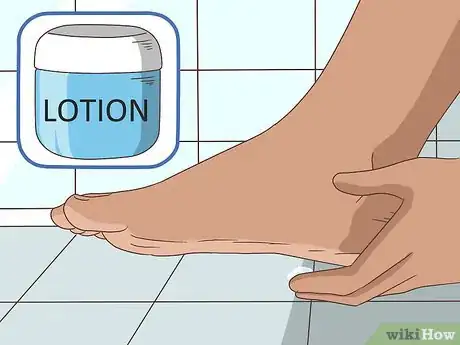
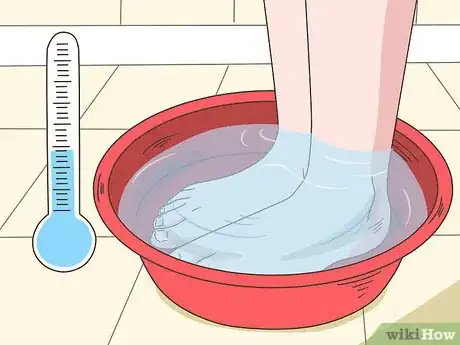


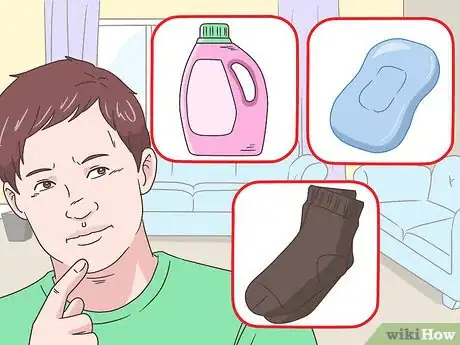



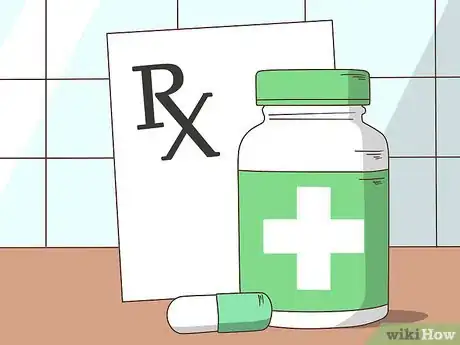

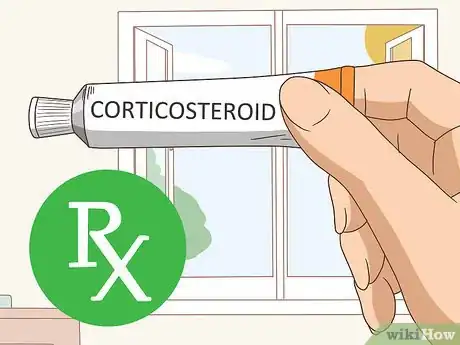


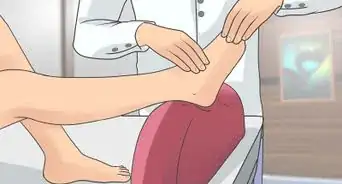
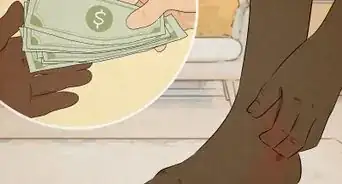

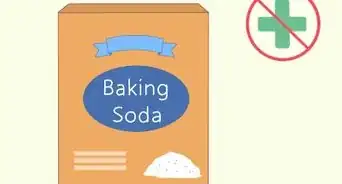
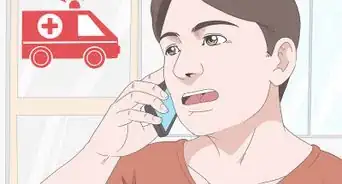
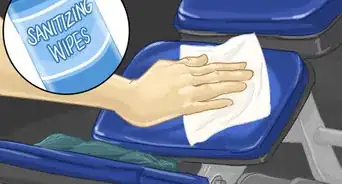
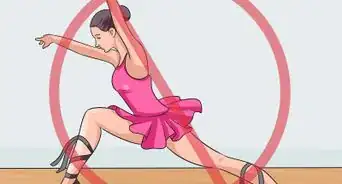

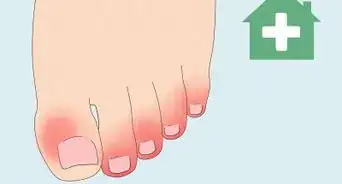
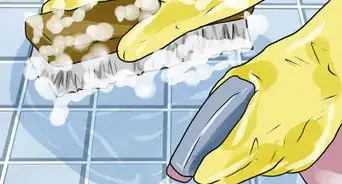
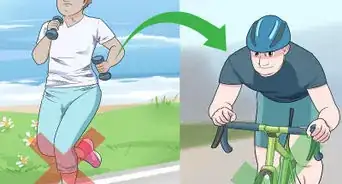
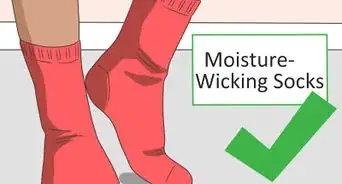
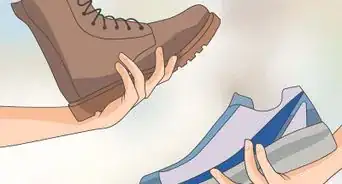







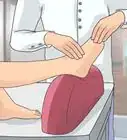
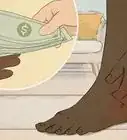

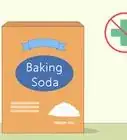



































Medical Disclaimer
The content of this article is not intended to be a substitute for professional medical advice, examination, diagnosis, or treatment. You should always contact your doctor or other qualified healthcare professional before starting, changing, or stopping any kind of health treatment.
Read More...